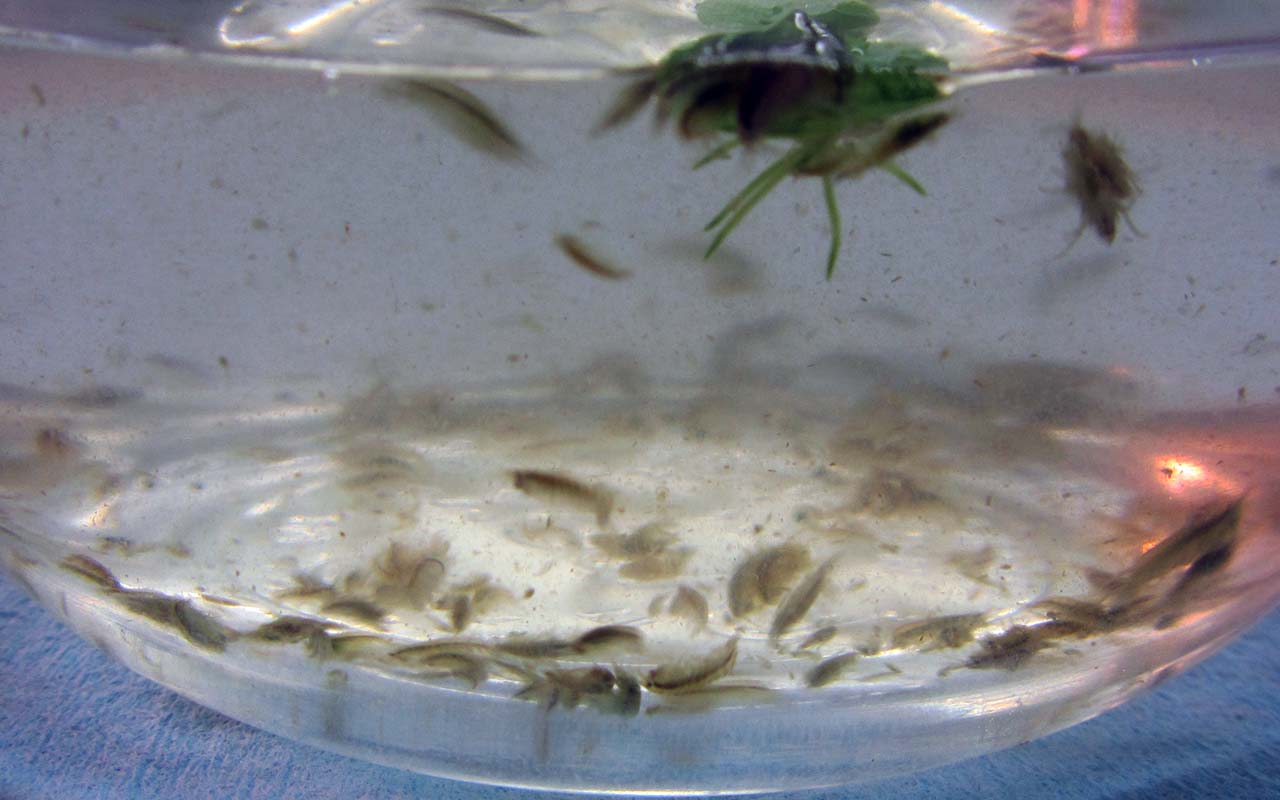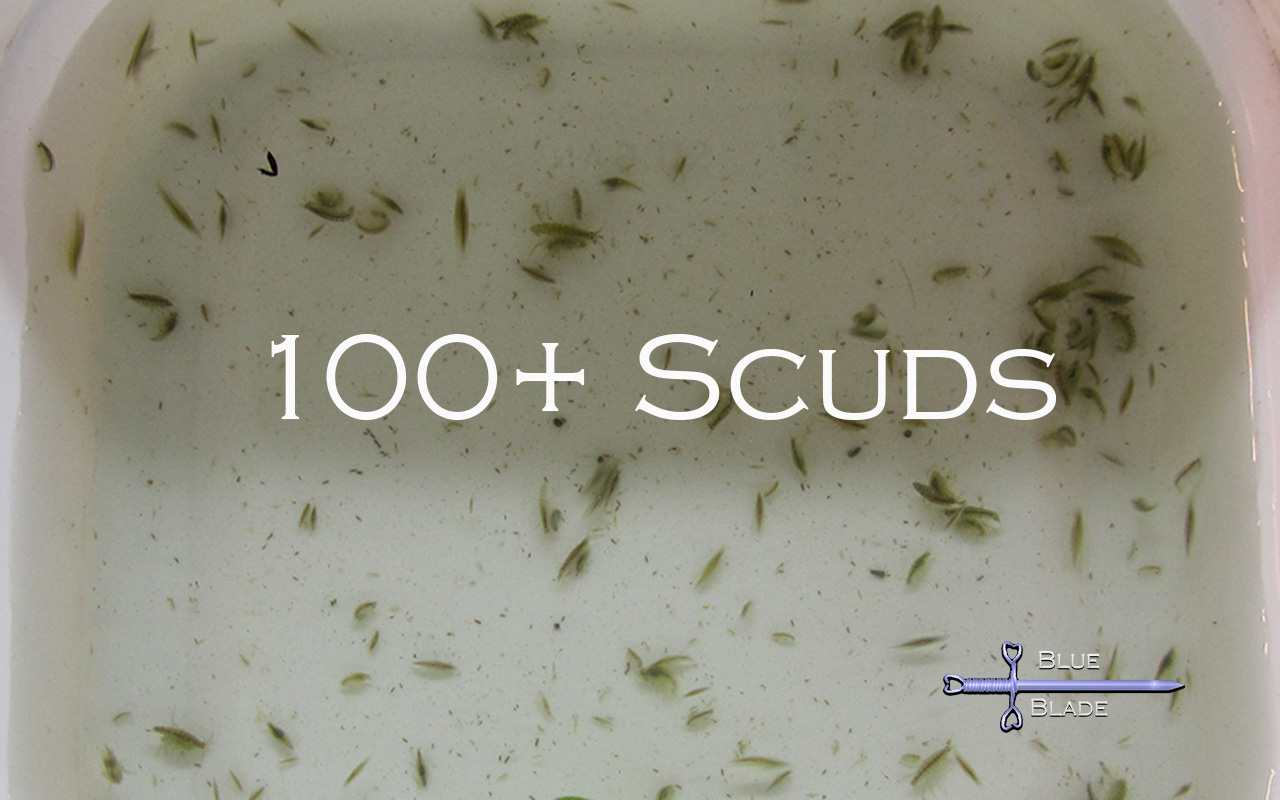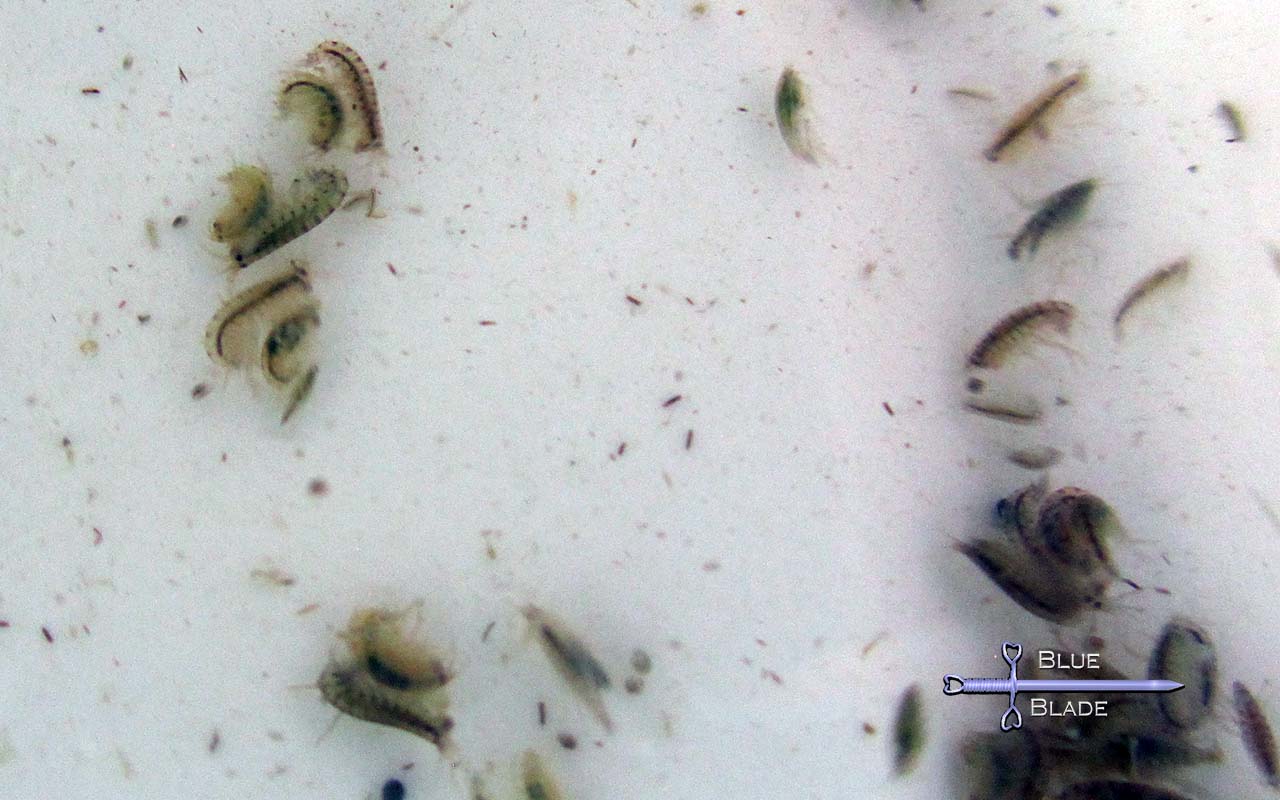
Materials:
1) Culture vessel (tank, jar, tub)
2) Clean water
3) Light (electric or sunlight)
4) Food (fish food, vegetables, plants)
5) Air Pump and tubing
6) Starter culture
Scuds are freshwater amphipods that grow to 6mm or 1/4th of an inch long. They are scavengers, and like snails they will eat algae or almost any foods they can find. Fish will happily chase them down and eat them, but scuds will swim for cover and hide if they can. In a tank with some cover they often survive and reproduce - making them a long-term snack for your fish. We culture the Hyalella Azteca species common in the southern US.
A Scuds culture is much easier than maintaining a basic aquarium of the same size. No filtration is needed. Some bubbles to stir the water helps prevent mosquitoes. They thrive at any temperature a person would find remotely comfortable, and survive near freezing, so no heater is needed. They eat most any vegetable matter or foods. And with adequate hiding places, such as course gravel, they often survive and reproduce in your fish tank.
It only takes a few start a culture, but the more you start with the sooner you will be able to harvest some for feeding. You can buy bottles of starter cultures of live Scuds taken from our mother cultures for sale here.
Once you have your starter, it's time to grow and propagate.
There are 2 main aspects to culturing Scuds:
1) Water
2) Food

Water
Almost any size container can be used to hold the water Scuds will grow in. Larger water volumes allow for larger cultures. I recommend at least a 1-gallon jar in a sunny window. 10-gallon tanks or 5-to-30-gallon plastic bins also make excellent culture vessels
They are very hardy - able to survive and often thrive in temperature, PH, hardness, and oxygen levels that would be bad for most fish. Any dechlorinated water should be fine for them. Aged fish tank water (without medications) is ideal for them. Scuds live well in very "dirty" water. Water changes are not essential.
They can survive in stagnant water with low oxygen levels, but I recommend some water flow. They will grow in larger numbers with more flow, and the circulation keeps Mosquito larvae from developing. Any Air stone or small pump is adequate.

Food:
To grow the culture, it must be well fed. The best foods are green vegetables. Scuds are detritivores and will eat any decaying matter. They also love algae.
The order of preference appears to be:
1) decaying animal matter (fish food, dead fish or snails, etc.)
2) algae - all types, including Hair algae
3) Dead or Dying plant matter (trimmings, vegetables, etc.)
4) live plants.
For my scud cultures I generally just feed them plant trimmings. Whenever I trim plants or net loose leaves from my other tanks, I throw those into the scud bin. I also feed them pellets and flakes when I feed the fish.
They are very useful to clean up plants that have become covered in algae. Have an Anubis that is covered in hair algae? Toss it in the scud bid for a little while. They will eat all the algae and dying leaves - then take it out. Just don't leave it in there for too long, as hungry scuds will eventually decide to eat the healthy plant.
Culture Process:
On Day 1 of a new culture: place your container in a well-lit or sunny location, add clean chlorine-free water, set up an air pump and drop in an airline weighted so that the end sits near the bottom, and adjust the airflow. Float the starter culture for a few minutes to temperature acclimate it, and then add the scuds. add a small amount of food.
First week: Check the culture daily to see if the food is gone. Feed daily or as needed. You should get a feen for how often food is needed, based on why types of food you feed.
Weekly: once the culture reaches a few hundred scuds you can consider it a stable colony. You may harvest as often as you like. You can harvest up to half of the population, make sure to leave at least 50 scuds to repopulate. Smaller amounts may be taken more frequently. Overpopulation is not an issue, so you do not need to harvest regularly. The easiest way to harvest is to place a piece of potato on a fork, and then take once it is covered in scuds, take it out and swish it in a small bowl of tank water. You can then put the fork back and repeat every 5 to 10 minutes. You may then use a dropper to feed the scuds to your fish. A fish net can be used, but it is difficult to separate the scuds from the net. One method it to scoop the scuds into the net, and then just place the net in your fish tank and let the fish pick the scuds off.
Notes:
- Light with a day/night cycle appears may be important. They don't grow as well in a dark closet.
- They are survivors. Once you add Scuds to a tank, expect a few to survive and continue reproducing. So be cautious as to where you introduce them. If there are no fish, no predators, (such as in a shrimp tank) they may take over.
- Scuds can be an effective way to clean up an aquarium with algae issues - if the fish don't eat them first.
To get your own starter cultures check out the Links under "Buy Here"
Or contact us to see if more is available or for info on any project or culture. Please email us at contact@bluebladefish.com